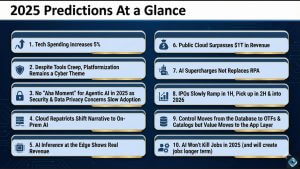Premise
VAST Data is attempting one of the most audacious pivots we have seen from an infrastructure vendor in the last decade. Having vaulted past $2 billion in cumulative software revenue in under six years, faster than any data-infrastructure company on record, the firm now claims it is only one step short of delivering a full AI Operating System. VAST’s new AI OS layers distributed scheduling, event streaming, vector search, database indexing and an agent-execution framework atop its disaggregated, shared-everything (DASE) storage core. The goal is to turn the company’s exabyte-scale flash tier into a single, global substrate on which millions of GPUs and, eventually, trillions of software agents can reason over data in real time.
The ambition is clear. Yet in our view, VAST has not (yet) achieved a Databricks-style lakehouse, a Snowflake-grade cloud database, nor a hyperscaler data platform. Its “database” remains an index optimized for metadata and vectors, not a full ANSI-SQL engine with mature governance. Bridging that gap while sustaining hyper-growth, (4.9x year-on-year in FY 2026 Q1 alone) will be the true test of the company’s long term strategy.
Why this Matters
We believe the AI era will be defined less by monolithic applications and more by distributed “agentic” workflows that continuously embed, enrich and act on data. Moreover, today’s enterprise data stacks remain fragmented across object storage, data warehouses, stream processors and MLOps pipelines, leaving CIOs and data pros with brittle, latency-hindered architectures with many asynchronous and dependent processes that slow down time to outcome.
VAST’s big bet is that collapsing storage, database, stream processing and agent-runtime layers into a single software fabric will unlock a step-function in developer productivity and GPU utilization, particularly for neo clouds such as CoreWeave, Lambda, Nebius and others that already standardize on, or at least heavily utilize, VAST for shared-flash tiers. In addition, many of the leading banks and financial services institutions we speak with are excited about VAST’s vision and its products. The majority of the firms we speak with are building on-prem/hybrid AI stacks and see VAST as an integral part of their emerging AI architecture.
Business Velocity: Hyper-growth with Positive Cash Flow
- Fastest to $2 billion. VAST’s cumulative software bookings crossed the $2 billion mark in less than six years. The company claims this outpaces prior record-holders in the data-management arena. Our guess would be Snowflake would be the closest public company where this claim can be audited. Databricks as well but the data is less clear as they remain privately held.
- Growth is impressive. According to the company, FY 2025 revenue expanded 3.6x, while the most recent quarter approached 5x year-on-year.
- Cash-flow accretive. Cash-flow accretive. Amazingly for a startup, management claims free cash flow is positive and we believe it is becoming increasingly meaningful as the company grows. While vague in terms of hard metrics, it’s an important signal that hyper-growth is not being fueled purely by cash burn.
Our view is that this velocity, along with a claimed 99.9991% measured uptime and an NPS of 84, has earned VAST a seat at the AI-infrastructure table with hyperscalers, sovereign clouds and one-quarter of the Fortune 100. The OEM channel is also widening Dell’s E-Box initiative, Cisco’s HyperFabric and even China-based XFusion are now in play.
Architectural Thesis: From Universal Storage Layer to a Global Data and Compute Fabric
VAST’s original differentiator was DASE, an all-flash, shared-everything storage design that eliminates data partitioning and delivers HDD-equivalent dollars-per-terabyte with NVMe latency. The company is now layering five software domains atop that core:
| Layer | What it delivers | Status |
| DataStore | Scalable file/Object/volume services | Shipping |
| DataBase | Real-time metadata & vector index | Shipping |
| DataEngine | Container & function runtime, triggers, stream ingest (Kafka) | 2025 GA |
| InsightEngine | Embedding micro-services for contextual enrichment | 2H 2025 |
| AgentEngine | Low-/no-code framework for building and orchestrating AI agents | 2H 2025 |
Everything is exposed through a unified namespace that spans on-prem clusters, public cloud zones and edge footprints, with a router that decides when to move compute to data or vice-versa.
Evaluating the “Operating System” Claim
Is VAST truly an “AI Operating System?”
- Positives supporting the claim
- Leveraging data gravity. By abstracting flash pools across estates, VAST can co-locate GPU jobs with data far more flexibly than traditional NAS or SAN silos.
- Agent-native primitives. Integrated vector search, stream triggers and function runtimes reduce the plumbing required to build retrieval-augmented generation (RAG) pipelines and autonomous agents.
- Single tier, flash economics. The company’s assertion that HDDs are obsolete for primary workloads looks increasingly credible as QLC NAND and PCIe 5.0 drive $/TB below $0.10. A trend we’ve predicted for many years appears to be closing into reality.
- Leveraging data gravity. By abstracting flash pools across estates, VAST can co-locate GPU jobs with data far more flexibly than traditional NAS or SAN silos.
- Gaps to the claim
- Not (truly) a full analytic DB. The VAST DataBase is a distributed index; it lacks the mature SQL optimizer, cost-based query planning, role-based governance and rich BI ecosystem that enterprises expect from Snowflake or BigQuery.
- Ecosystem inertia. Databricks’ Mosaic, Snowflake Cortex and AWS Bedrock are already courting the AI-agent developer with native vector stores, fine-tuning services and governance layers. VAST must persuade the industry that its integrated flash fabric offsets the network effects and inertia of those platforms.
- Execution complexity. Merging storage, database, stream processing and container scheduling into a single stack is a tall order. Sustaining VAST’s impressive reliability and NPS scores at scale while shipping new OS layers every quarter is non-trivial.
- Not (truly) a full analytic DB. The VAST DataBase is a distributed index; it lacks the mature SQL optimizer, cost-based query planning, role-based governance and rich BI ecosystem that enterprises expect from Snowflake or BigQuery.
Market implications
For AI clouds. CoreWeave’s endorsement carries real weight given its high profile public offering. By placing hundreds of thousands of GPUs on the VAST fabric, the AI cloud specialist has demonstrated that the architecture can scale far beyond lab experiments. Should the major hyperscalers follow through on what VAST management hints is first-party service interest, NetApp’s Ontap, Dell PowerScale and even Amazon’s own FSx offerings would suddenly find themselves facing a potent new high water mark for shared flash and vector-native storage performance.
For enterprise data centers. For Global 2000 organisations that are struggling with distributed GPU clusters and a maze of data silos, VAST positions itself as an AI factory in a box (a marketing concept Dell has also popularized) collapsing storage, vector indexing and low-latency data services into one platform. The technological allure is there. The cultural challenge will be persuading data engineers and platform teams to step away from (or at least integrating) the Spark, Delta and Iceberg metastores they have spent years hardening for compliance and governance. Moreover, as Snowflake becomes a somewhat more open platform and hyperscalers vie for their fare share, VAST is now competing in a much bigger pond. If they get a fair share of that larger pond it’s a big win for the company.
For channel partners and OEMs. Partnering with Dell, Cisco, Lenovo, Supermicro HPE and others, gives those giants a credible offering in the space. It offers an AI-first storage and compute narrative without forcing them to build vector databases from scratch; or buys them time to build their own if they choose to do so. For VAST, a diversified OEM channel not only multiplies reach but also mitigates the risk of over-reliance on a handful of fast-growing GPU clouds whose spending could ebb as the market consolidates. Unlike other OEM deals we’ve seen, VAST’s wider base of partners reduces exposure to the whims of a single brand.
Key takeaways
VAST is attempting one of the more audacious pivots we have seen in infrastructure, moving from a high-performance AI storage vendor to an operating-system provider and positioning itself as the control plane for distributed, agentic computing. If management can execute, the total addressable market could balloon from roughly $10 billion in premium flash storage to what the company describes as a $15 trillion AI-era opportunity. Importantly, this expansion is being funded out of operations rather than debt or venture burn. Surpassing $2 billion in cumulative software sales while remaining FCF positive sets VAST apart from the growth-at-any-cost mindset.
Architecturally, VAST has engineered for the agentic era by combining integrated vector indexing, real-time event triggers and a low-code agent engine directly on top of its disaggregated flash fabric. That design should resonate with customers as they shift from monolithic applications to autonomous workloads. Still, the company is not a lakehouse with mature tooling, full ANSI-SQL, robust governance and a broad ISV ecosystem. In our view, VAST complements rather than replaces Databricks, Snowflake or BigQuery. The further it pushes up the stack, the steeper the execution hurdle. Fusing storage, database, streaming and orchestration into a single, highly resilient code base at low cost is a tall order and will tax its engineering resource as well as its support and release cadence. It will be critical for the company to move at the speed of NVIDIA, which so far it appears to be doing. We see the OEM channel as a mixed blessing. Firms like HPE, Dell and Cisco extend VAST’s reach, but those partners could squeeze gross margins, blur brand identity and if the balance of power tilts too far toward the integrator, it can cause shocks to the system.
Bottom line
In our opinion, VAST Data is navigating the classic innovator’s dilemma in reverse, as a disruptor It’s moving from a niche infrastructure specialist, attempting to dislodge the platform incumbents by moving up the stack with an architecture built for the AI era. The company’s DASE architecture, impressive uptime metrics and early GPU-cloud wins give it a legitimate shot (albeit a longshot) at becoming the flash-era analogue to Sun’s Solaris or even possibly even VMware’s ESX – i.e. a ubiquitous substrate that unlocks a new class of computing. But to fulfill that promise, VAST must mature its database, harden its agent runtime and cultivate a developer ecosystem as rich as the lakehouse and hyperscaler communities it aims to displace. If it succeeds, the industry may look back on 2025 as the year a storage vendor rewrote the operating-system playbook for the AI age.



